
By Mike Ford - NOAA National Marine Fisheries Service and Smithsonian Environmental Research Center
Dhugal Lindsay - Japan Agency for Marine-Earth Science and Technology
Amanda N. Netburn - Cooperative Institute for Ocean Exploration, Research, and Technology at Florida Atlantic University and NOAA Office of Ocean Exploration and Research
September 23, 2017

Alepisaurus ferox, also known as the lancetfish. This individual was completely straight and looking toward the surface when we encountered it in the midwater, a behavior seen in other fish as well, such as the Serrivomeridae, that were common throughout the expedition. Image courtesy of the NOAA Office of Ocean Exploration and Research, Deep-Sea Symphony: Exploring the Musicians Seamounts. Download larger version (jpg, 902 KB).
Ocean exploration at the Musician Seamounts hit a crescendo during the Deep-Sea Symphony expedition that pleasantly reverberates in our minds today. We are just three explorers out of a team of nearly 20 that peered through the high-definition video cameras of the remotely operated vehicle (ROV) Deep Discoverer (D2, for short) whose bounty of imagery instantly appeared in screen-studded exploration command centers around the world. Thanks to the latest seafloor-to-satellite communications, which can vault video and data from the deep ocean nearly instantaneously to our labs, we dove vicariously through D2.
Our team of explorers includes zoologists, systematists, taxonomists, ecologists, engineers, and oceanographers who study fishes, gelatinous animals, squids, and other creatures that live in an enormous ocean realm called the midwater. The midwater is a part of the deep ocean that plunges from 200 meters (~656 feet) down to the seafloor and envelopes the globe. It is the largest habitable region on Earth for multicellular life forms. We had the great pleasure of being the first explorers to look into this (until now) unseen part of the ocean in the central Pacific Ocean.
Four times after a dive to the seafloor, we explored the midwater – a short tour before recovering the vehicles for a restful night aboard NOAA Ship Okeanos Explorer. On two special days, we engaged in a marathon of exploration with full-day midwater dives – prime time for our community. This was a first for our band of scientists and a milestone for NOAA’s ocean exploration efforts. Sitting at the edge of our seats and pushing our mental field books to the limits, we busily communicated what we saw and logged observations into our data systems.
We did not know what lives in the midwater in this part of the ocean. We found several new species and extended the known range of many others. By applying our biological knowledge of these organisms, we get glimpses of how the midwater food web works and how the environment affects life down there. Our plan: characterize the volume we explore, document everything as precisely as possible, and then analyze our results.
Every time one of three polar-orbiting satellites passed over the Okeanos Explorer while racing in an orbit around Earth, we would get maps of surface algal concentration, sea surface temperature, and surface ocean currents. Like maps of the seafloor, these satellite images tell us what features on the surface might affect what or how many organisms we would see at depth.
We use ship sonar from the Okeanos Explorer and oceanographic instruments on D2 to look vertically through the water column. Our precise ship sonar far exceeds the normal fish finder, bouncing numerous wavelengths of sound off layers of fish and gelatinous animals. This layer, the deep scattering layer, is the sweet spot for finding midwater animals. Our oceanographic instruments on D2 tell us about any distinct layers of saltiness (called salinity), temperature, and oxygen – clues that reveal deep ocean currents that can transport different animals into our viewing area.
Since we were the first ones to look into this part of the ocean, we hooked up as many data streams as possible from this big blue world with as many instruments as we could muster.
Our exploration command center would erupt in cheers when we saw rare or new species of midwater animals. Of the nearly 1,200 observations made during 24 hours of ROV time, we highlight below some examples of what we discovered.
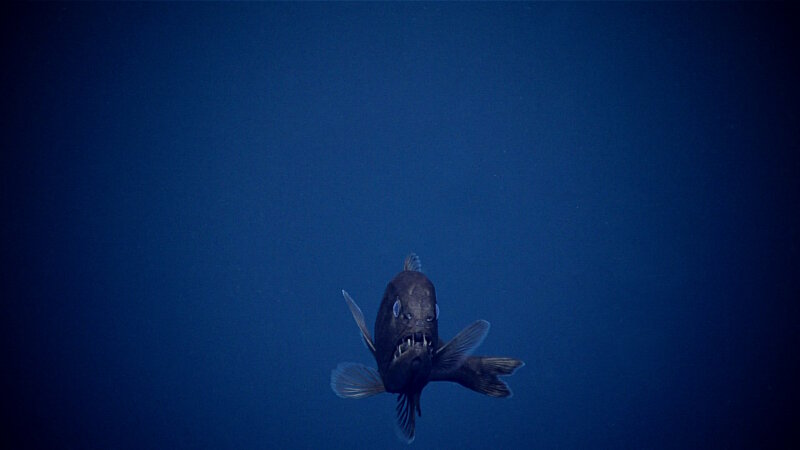
This species of Anoplogaster, known as a fangtooth, spent some time considering what Deep Discoverer was doing down there. Image courtesy of the NOAA Office of Ocean Exploration and Research, Deep-Sea Symphony: Exploring the Musicians Seamounts. Download larger version (jpg, 1.1 MB).
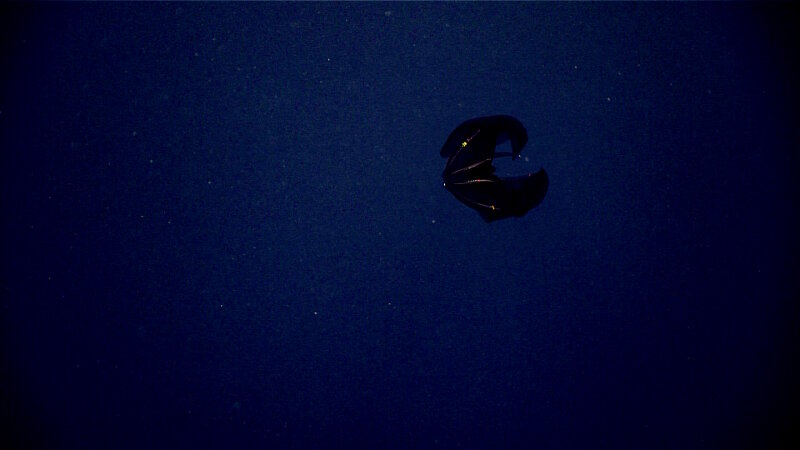
This dark red species of Lampocteis is a lobate ctenophore nicknamed the samurai helmet jelly. Many midwater animals feature dark red coloration. Image courtesy of the NOAA Office of Ocean Exploration and Research, Deep-Sea Symphony: Exploring the Musicians Seamounts. Download larger version (jpg, 1.3 MB).
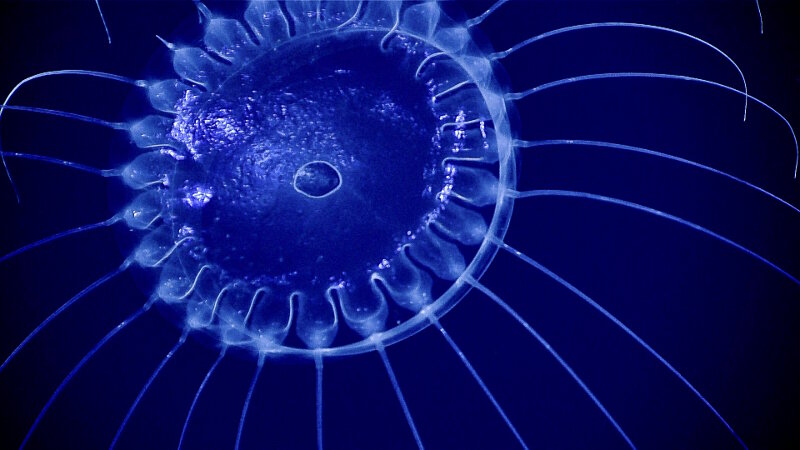
Sometimes the animals strike the perfect pose for us. This species of Solmissus, or dinner plate jelly, was seen during our last set of midwater transects of the Deep-Sea Symphony expedition. We can clearly see 26 tentacles extending outward from its bell. Solmissus is known to capture and eat other jellies. Image courtesy of the NOAA Office of Ocean Exploration and Research, Deep-Sea Symphony: Exploring the Musicians Seamounts. Download larger version (jpg, 1.5 MB).
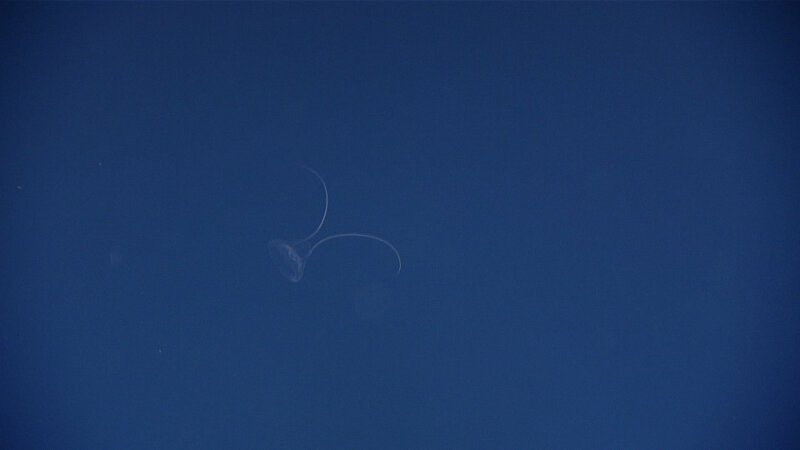
Solmandella, two sword jelly spotted in the water column during the Deep-Sea Symphony expedition. Image courtesy of the NOAA Office of Ocean Exploration and Research, Deep-Sea Symphony: Exploring the Musicians Seamounts. Download larger version (jpg, 741 KB).

Halicreas minimum, the warty clubfoot jelly, shown here with an amphipod along for the ride. While on its ride, the amphipod may eat the tentacles of the jelly. Image courtesy of the NOAA Office of Ocean Exploration and Research, Deep-Sea Symphony: Exploring the Musicians Seamounts. Download larger version (jpg, 1.1 MB).
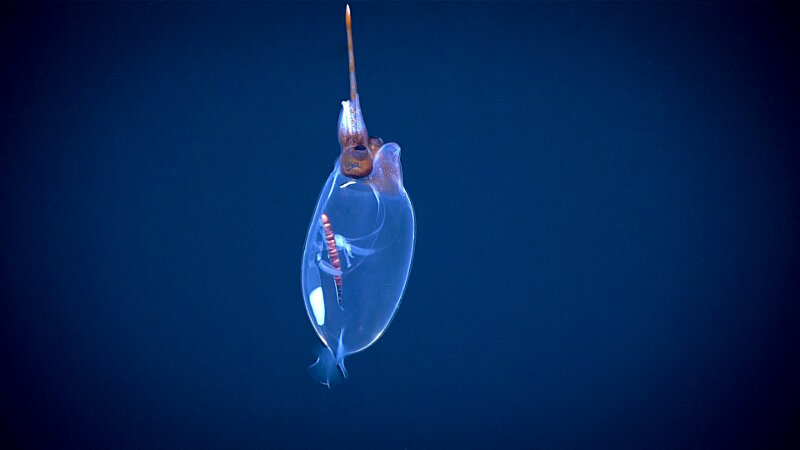
After seeing some squid ink in the water, we finally encountered this boarlet squid. It is no surprise that this animal is from the family Cranchiidae, also known as the glass squids. Image courtesy of the NOAA Office of Ocean Exploration and Research, Deep-Sea Symphony: Exploring the Musicians Seamounts. Download larger version (jpg, 974 KB).
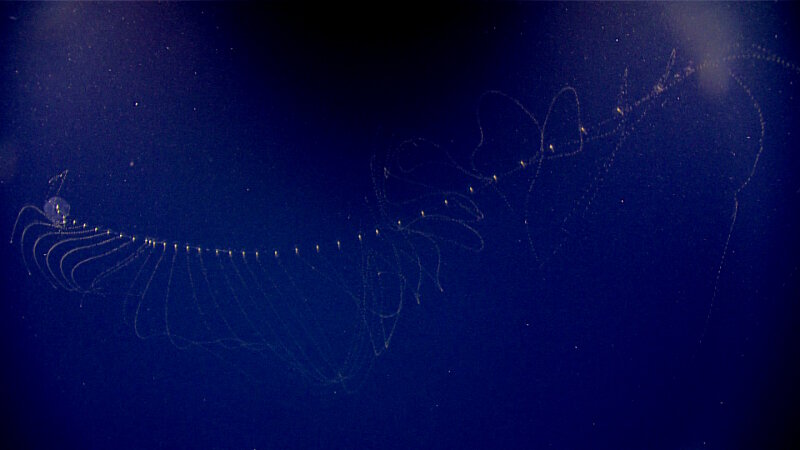
A prayid siphonophore was discovered with tentacles extended from the long siphosome ready to capture prey. Our ROV allows us to encounter animals without disruption, to capture sequences of foraging behavior not possible with traditional net sampling. Image courtesy of the NOAA Office of Ocean Exploration and Research, Deep-Sea Symphony: Exploring the Musicians Seamounts. Download larger version (jpg, 1.3 MB).
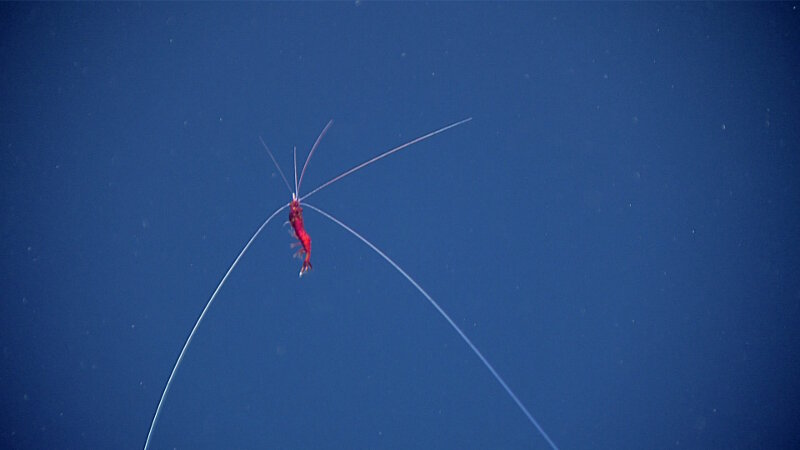
Many midwater animals have long, slender appendages. This sergestiid shrimp is an excellent example with its long antennae reaching out to detect movement. Image courtesy of the NOAA Office of Ocean Exploration and Research, Deep-Sea Symphony: Exploring the Musicians Seamounts. Download larger version (jpg, 800 KB).
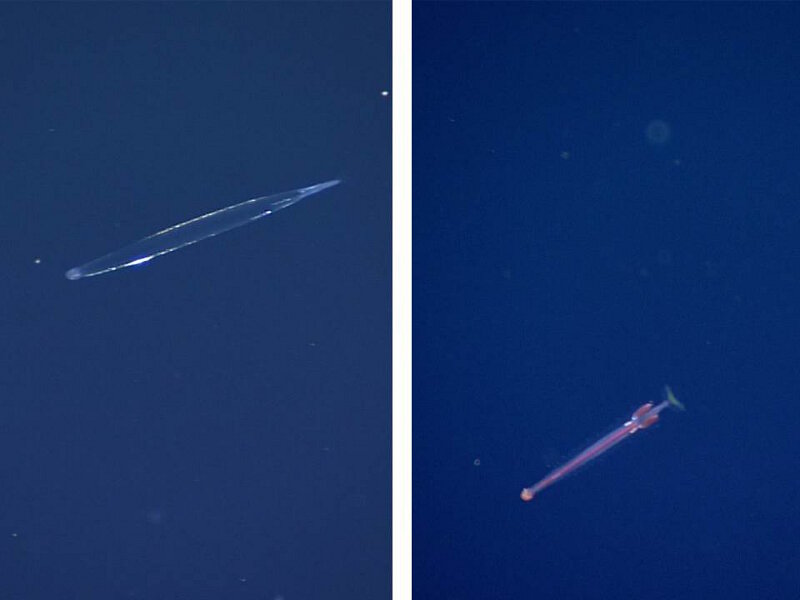
Chaetognaths (common name "arrowworms") were extremely abundant on the midwater dives in the Musicians Seamounts region, inhabiting a broad depth range. Deeper-dwelling species tend to be more pigmented (red/orange, right) while shallower species are often transparent (left). These variations in coloration are adaptations to the ambient environments. Red animals appear black in the poorly lit deep ocean, which helps them camouflage in their environment, while transparency is a good strategy to stay hidden in better-lit shallower water. Left image courtesy of the NOAA Office of Ocean Exploration and Research, Deep-Sea Symphony: Exploring the Musicians Seamounts. Right image courtesy of the NOAA Office of Ocean Exploration and Research, 2017 Laulima O Ka Moana. Download larger version (jpg, 128 KB).

An oikopluerid, or larvacean inside its elaborately shaped gelatinous house. Used as a filtration apparatus for feeding, this structure is replaced after a couple of days. The animal within will swim out to make a new house as this one sinks to the seafloor. Image courtesy of the NOAA Office of Ocean Exploration and Research, Deep-Sea Symphony: Exploring the Musicians Seamounts. Download larger version (jpg, 756 KB).